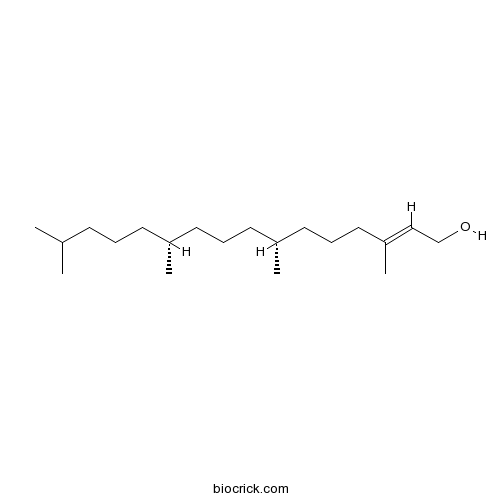Fokienia hodginsii
Fokienia hodginsii
1. The products in our compound library are selected from thousands of unique natural products; 2. It has the characteristics of diverse structure, diverse sources and wide coverage of activities; 3. Provide information on the activity of products from major journals, patents and research reports around the world, providing theoretical direction and research basis for further research and screening; 4. Free combination according to the type, source, target and disease of natural product; 5. The compound powder is placed in a covered tube and then discharged into a 10 x 10 cryostat; 6. Transport in ice pack or dry ice pack. Please store it at -20 °C as soon as possible after receiving the product, and use it as soon as possible after opening.
Natural products/compounds from Fokienia hodginsii
- Cat.No. Product Name CAS Number COA
-
BCN1673
Phytol150-86-7
Instructions

-
BCN4442
Salicyl alcohol90-01-7
Instructions

Tree growth response of Fokienia hodginsii to recent climate warming and drought in southwest China.[Pubmed: 28865051]
To date, few attempts have been made to assess the influence of climate change on forest ecosystems and on the relationship between tree growth and climate in humid areas of low latitudes. In this paper, we studied the response of tree growth and forest ecosystem to climate change by using Fokienia hodginsii tree-ring cores from the northern Yunnan-Guizhou Plateau, southwest of China. Tree growth correlates the highest (r = -0.64, p < 0.01) with mean temperature (July-September), but the coefficients were changing with time as revealed by a moving correlation analysis. Tree growth is significantly (p < 0.05) and positively correlated with January-April mean temperature from AD 1961-1987, while correlations with precipitation are insignificant. In contrast, from 1988 to 2014, tree growth correlated negatively with mean temperature of previous summer and positively with precipitation of previous August-September. This indicated that the limiting factors for tree growth have changed under different climate conditions. The meteorological data suggested that from 1961 to 1987 it was cold and wet in the study area and radial growth is limited by winter and spring temperatures. This restriction is weaker if the climate is appropriate in general. However, from 1988 to 2014, the combined effects of recent warming and decreasing precipitation have led to an increasing response of tree-ring width to drought. In addition, a large proportion of mature F. hodginsii mortality occurred from 2007 to 2013, which corresponds with a drastic reduction of radial growth (narrowest in recent 100 years). The recent drought, induced by decreasing precipitation and increasing temperature, may have passed the threshold which F. hodginsii could tolerate, causing tree growth reduction, tree growth-climate relationship change, as well as catastrophic tree mortality. All these changes may lead to further responses of the local ecosystem to climate change which should be highly regarded.
Sesquiterpenoids from the twigs and leaves of Fokienia hodginsii.[Pubmed: 27989219]
A rare carotane-type sesquiterpenoid, forkienin A (1), a new eudesmane-type sesquiterpenoid, forkienin B (2), and a new natural eudesmane-type sesquiterpenoid, forkienin C (3), were isolated from the twigs and leaves of Fokienia hodginsii, along with eight known sesquiterpenoids. The structures of the new compounds were elucidated on the basis of their spectroscopic analysis, including 1D and 2D NMR methods. All compounds were evaluated for cytotoxicity against HL-60, SMMC-7721, A-549, MCF-7, and SW480 cell lines.
Diterpenoids from the twigs and leaves of Fokienia hodginsii.[Pubmed: 23691952]
Five new isopimarane diterpenoids, fokihodgins A-E (1-5), four new labdane diterpenoids, fokihodgins F-I (6-9), and one new icetexane diterpenoid, fokihodgin J (10), as well as 18 known diterpenoids were isolated from Fokienia hodginsii. The structures of the new compounds were determined on the basis of their spectroscopic analysis, and the absolute configurations of 1 and 6 were established by X-ray crystallographic analysis. Compound 9 showed moderate cytotoxicity against HL-60 and SMMC-7721 cell lines, with IC50 values of 9.10 and 7.50 μM, respectively.
[Population structure and community characteristics of Pseudotaxus chienii in Fengyangshan National Natural Reserve].[Pubmed: 16252850]
Pseudotaxus chienii, an endemic plant in China, is one of the second grade state protection wild plants, and distributes in Fengyangshan Natural Reserve as one of its concentrative dwelling places. A survey in the region was carried out on 10 communities, which were dominated by P. chienii. The analysis on its size structure, spatial distribution pattern and community characteristics showed that the populations of P. chienii could grow in the communities dominated by Rhododendron simiarum, Fokienia hodginsii-R. simiarum, and evergreen broad-leaved forests. In R. simiarum communities, the size structure, survival curve, and overwhelming community distribution pattern of P. chienii showed a sustaining development, while in communities dominated by F. hodginsii-R. simiarum, though the size structure was declining, the survival curve was Deevy- III type. Plenty of plantlets were still existed, and the populations kept steady. Two types were considered to be the most suitable ones for P. chienii populations. The important value of P. chienii reached 5% - 10%. In evergreen broad-leaved forests, the populations of P. chienii showed to be a declining type, and the survival curve was Deevy- II type. The distribution pattern was random, indicating that P. chienii populations could not fit for survive in this kind of communities. Correlation analysis showed that P. chienii populations had a positive correlation with R. simiarum and F. hodginsii, but a negative correlation with Cyclobalanopsis stewardiana and Schima superba. P. chienii could associate to the habits with the community canopy density of about 0.6 - 0.8. From the results mentioned above, the populations of P. chienii could be able to sustain and develop, and the existing habitat in Fengyangshan should be protected effectively. The protection of P. chienii requires more basic work to establish efficient measures to protect its habitat.


